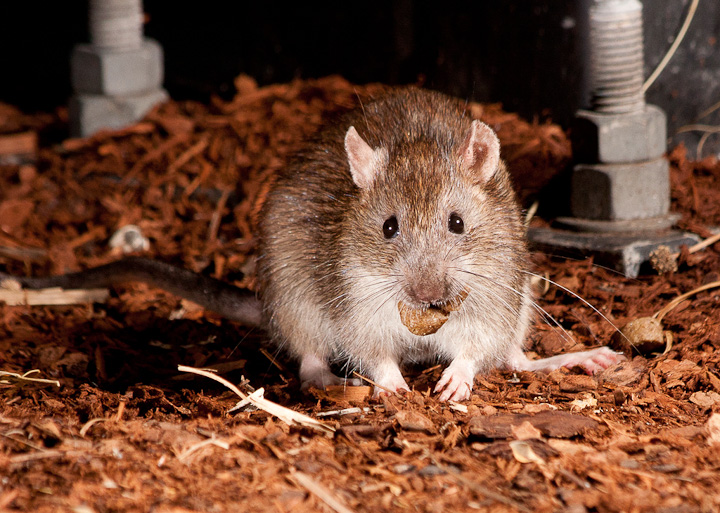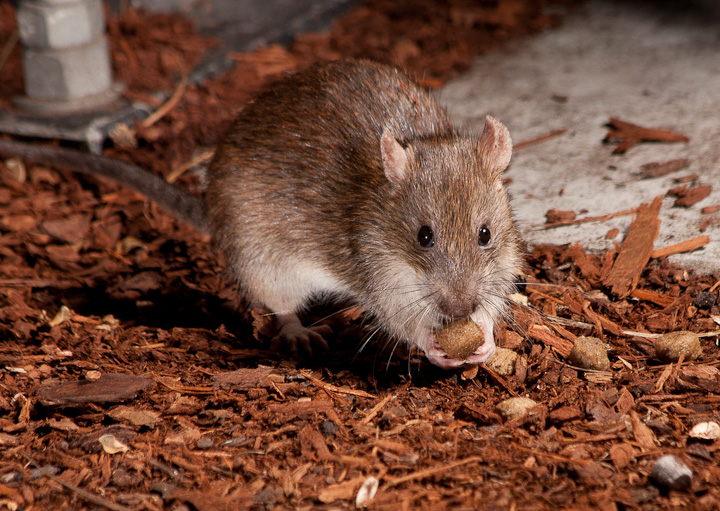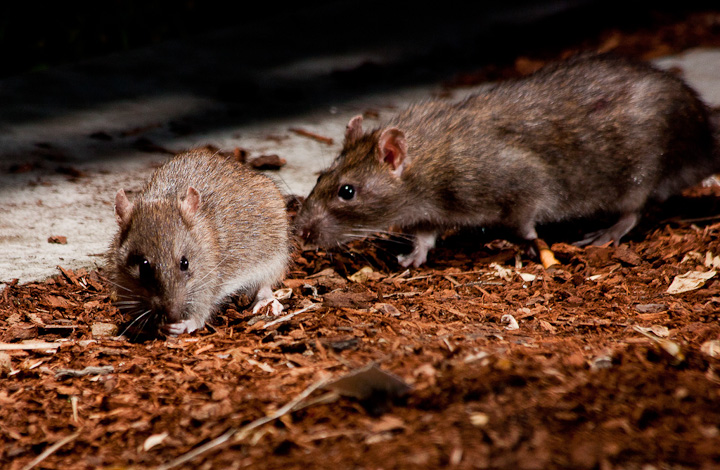
They say that if you want to take better pictures, you need to stand in front of more interesting stuff. This certainly has some truth to it, and is one of the reasons why investment in a photo expedition can be so much more useful than allocating tons of money on new cameras and lenses. But a trip to an exotic far-flung locale does not really fit in with the Cheapskate Tuesday philosophy, so how about a photo safari closer to home?
Shooting Norway Rats (Rattus norvegicus) provides an opportunity to shoot an interesting, seldom-photographed subject in the heart of a city. Because they are nocturnal, they pose some unique challenges, namely lighting them properly! For these shots, I used 2 radio-controlled manual speedlights,which were set up to light a small area baited with common dog food. One could also use TTL triggers, such as the new YongNuo 622‘s and set the metering to spot to meter the subject, but I did not have these available. Instead, after guesstimating lighting ratios, I just played with the ISO and f-stop to get decent exposures.
Starting shortly after nightfall on a summer night in July, I chose an area with lots of foot traffic adjacent to a rail line. This ensured that the rats were used to human proximity and conditioned to search for littered food. An alleyway near some dumpsters would also work well. I shot these using a 70-300 zoom, and of course the faster the lens, the easier focusing will be, but choosing an area with some artificial light helps.
Because rats are neophobic (afraid of new things in their environment), I was worried that the speedlights would scare them off, but these rats that are habituated to a rapidly-changing litter landscape did not pay too much heed to some more crap lying around.

Depending on the season (I recommend early summer), the majority of rats you will encounter will be young, as rats are short-lived highly fecund creatures, meaning that the cohort of young individuals will greatly exceed the number of large, reproductively mature animals. These younger rats often have bright eyes and nice fur, which makes them rather cute.

Urban litter is often in the frames, adding some context to the shots.

Many of the rats I encountered had scars such as missing eyes, which indicates crowding in shelter areas and conspecific aggression.

The elegant form of the rat at a gallop is one of the most astounding sights in the natural world.


There is much more I would like to do with rats, such as triggering a camera with a wide angle remotely, and providing more natural foods, like pizza. Just imagine, a rat in front of a graffiti covered wall, dragging a massive slice of pizza! This is my art, this is my dream.
Anyway, I urge anyone to go try a rat safari, and wonder at the most urban of urban wildlife.
I have never been around wild rats, but my son’s pet rat, Lillie Sue, was one of the sweetest animals we ever shared space with. She watched TV in my son’s pocket every night until he would put her to bed. She came to us pregnant from the pet shop to our surprise and when she had her litter, we played with them for at least an hour before I called the pet shop and found out that we mustn’t touch them or she would eat them. But Lillie Sue loved us and her newborns too much for that. She was such a dear creature that we still miss her over twenty-five years later. I would have other rats would they only live longer. Four years was way too few years for our Lillie Sue.
I had rats when I was a kid as well. They are fun animals, and probably the best rodents to keep as pets. They do die young, but they pack a lot of life into their years.
I’ve taken to tossing dogfood to crows. They are challenging because they’re so dark.
true. They are tough to get nice exposures of, but are one of my favourites to photograph!
http://ibycter.com/2013/02/14/crow-portraits/
No need for me to go to a city to see rats, Sean. They’re common in my neighbourhood out in the suburbs of our Valley town. Of the two species most people are familiar with, the brown Norway rat & the black roof rat, I think the black one is much cuter looking. But it’s also the one that is supposed to have been responsible for having fleas that carried the bubonic plague. I’ve seen both outdoors at night as it’s when most small mammals emerge since it’s quieter. I like staying up & watching the animals then. Amazing how one can sit quietly outside, not moving, & animals will practically trip over you, not expecting any human to be out.
Rats do make great pets but it’s best to have two as they’re social animals & will be very needy for attention by themselves.
Rats can look elegant running but I think they look especially adorable when they bound along in long hops. Thankfully, we have a thick solid concrete foundation embedded roughly 2 feet down & comes up another 2 feet to form the lower wall of our partially above ground basement. Two neighbours have simple dirt cellars & problems with rats but not us. As long as they stay outside, I don’t mind them. I know they’ve built tunnels underground laced through people’s yards & mine but the raccoons seem to keep them in check a certain amount.
I think the Black Rats are cuter too, but they seem to be displaced in many areas by Norway Rats. I did see some Black Rats in Bella Bella, which is on a small island on the Central Coast of BC. They apparently persist in L.A., where they have taken to the trees.
I wonder if the techniques I used for these rats would be applicable for other nocturnal rodents…I would love to spend a bunch of time figuring it all out, but I have quite a bit on my plate for now, so I think I will have to stick to the city dwellers!
I’ve never photographed my pet rats with anything but my cell phone camera. They’re very attuned to what I’m doing and I don’t think they’d give me enough working distance to get nice shots!
Pingback: Cheapskate Tuesday 25: Einige Kleine NachtSpinnen | Ibycter